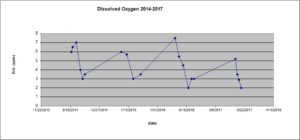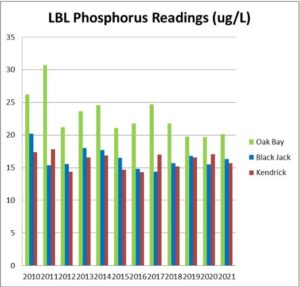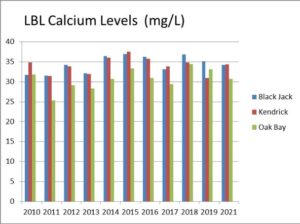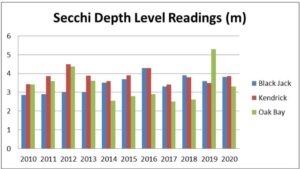2021 water results
Water Testing Results for 2021
Kendrick Bay, Black Jack Island and Oak Bay are all continuing to test in the middle of the trophic scale or mesotrophic. Our phosphorus data results for 2021 showed an increase in the phosphorus levels in both Oak Bay and the Black Jack area and a lower rate in the Kendrick Park area. As a lake community, we need to work on lowering our phosphorus inputs into the lake. Phosphorus levels are a big reason we see all the weed growth. Our Secchi depth levels for 2019 shot up in Oak Bay but all 3 area returned to their recently normal levels in 2020. Secchi levels show the clarity of the lake. Our calcium levels were up in 2018, lower in 2019, and both Oak Bay and Black Jack were down more in 2021 while Kendrick was back up a bit. We remain between 30 and 35 mg/L. When I googled calcium in lakes, I found that it has to do with the hardness/softness of the water. Moderate soft is between 20 and 40 mg/L. The past 3 summers have found us between 30 and 37 mg/L. Our data during the pandemic was sporadic as the lab shut down for a while. We only have Secchi data for 2020 and Phosphorus and Calcium data only for 2021. We are back on track and all 6 samples were taken in 2022.
Our thanks to Dave Johnson for taking the secchi and phosphorus readings for many years. Tom Heinze has now taken on that role.
Phosphorus levels explained…
An oligotrophic lake (phosphorus 0-12 ug/L) is a lake with low primary productivity, the result of low nutrient content. These lakes have low algae production, and consequently, often have very clear waters, with high drinking-water quality. The bottom waters of such lakes typically have ample oxygen; thus, such lakes often support many fish species, like lake trout, which require cold, well-oxygenated waters.
Mesotrophic or moderately enriched lakes (phosphorus 12-24 ug/L) are lakes with an intermediate level of productivity, greater than oligotrophic lakes, but less than eutrophic lakes. These lakes are commonly clear water lakes and ponds with beds of submerged aquatic plants and medium levels of nutrients.
An eutrophic or enriched (phosphorus 24-96 ug/L) body of water, commonly a lake or pond, has high biological productivity. Due to excessive nutrients, especially nitrogen and phosphorus, these water bodies are able to support an abundance of aquatic plants. Usually the water body will be dominated either by aquatic plants or algae. When aquatic plants dominate the water tends to be clear. When algae dominates the water tends to darker. The algae engages in photosynthesis which supplies oxygen to the fish and biota which inhabit these waters. Occasionally an excessive algae bloom will occur and can ultimately result in fish kills due to respiration by algae and bottom living bacteria. The process of eutrophication can occur naturally and by human impact on the environment.
Dissolved Oxygen Water Testing – summer 2017.
For another season, Dissolved Oxygen levels were monitored in one of the deeper parts of the lake. Most samples were collected between Lighthouse Point and English Island, in depths ranging from 60 to 80 feet. Dissolved Oxygen is important to various cold water species, including popular game fish. When organic sediments (such as decomposing weeds) from the surface sink to the bottom layers of deep water, the decomposition gradually depletes the oxygen available in these deeper areas. During much of the mid and later part of summer, the bottom layers of water do not mix with the surface water, so when deeper oxygen is depleted by decomposing sediments, it’s not replaced until the fall when lowering temperatures allow a mixing of deep and surface waters.
During the late spring and early summer of 2016, dissolved oxygen started in the 6 to 7 ppm (parts per million) range, considered good for most species, but dropped to the 2 to 3 ppm range in late summer. This lower range is considered marginal for survival of some aquatic organisms, including some desirable fish species.
The 2017 seasonal pattern has been generally consistent for the past few years. The late summer levels of D.O. indicate at least a moderate overabundance of organic sediments from such things as “weed” growth. This in turn usually relates to the nutrient levels (like phosphorus and nitrogen from development and agricultural sources) in the lake waters. Phosphorus sampling has been ongoing in Beverley Lake water for several years, in cooperation with the “Lake Partners” program, with results generally placing the lake in a middle level of concern for phosphorus levels. (For more information on phosphorus levels, see the Lake Partners program on the Ministry of Environment website.)
 Just before the pandemic shut the border down, LBLA purchased equipment to test dissolved oxygen more frequently. Testing was done in 2022 – the results will be forthcoming. It is believed that the equipment we purchased may be used to test additional areas for phosphorus. We are concerned about what the streams that bring water into LBL are carrying with it.
Just before the pandemic shut the border down, LBLA purchased equipment to test dissolved oxygen more frequently. Testing was done in 2022 – the results will be forthcoming. It is believed that the equipment we purchased may be used to test additional areas for phosphorus. We are concerned about what the streams that bring water into LBL are carrying with it.
Previous Water Quality Reports:
![]() Lower-Beverley-Lake-Water-Quality-through-2002
Lower-Beverley-Lake-Water-Quality-through-2002
![]() 1971 Water quality report p1-16
1971 Water quality report p1-16
![]() 1971 Water quality report p17-33
1971 Water quality report p17-33
![]() 1971 Water quality report p34-49
1971 Water quality report p34-49
Water Depth:
91.85 is the summer target depth. Our depth is regulated at the Lyndhurst Dam by MNR. There is a gauge on the side of the dam closest to Wings. MNR checks it often during the season.



